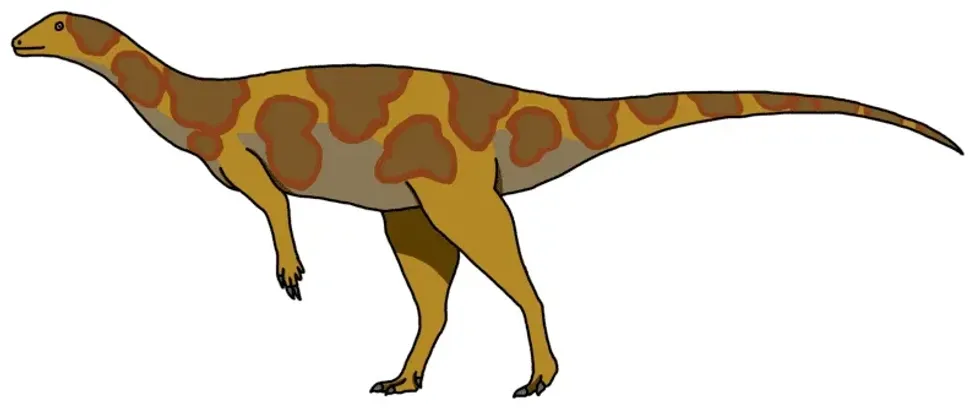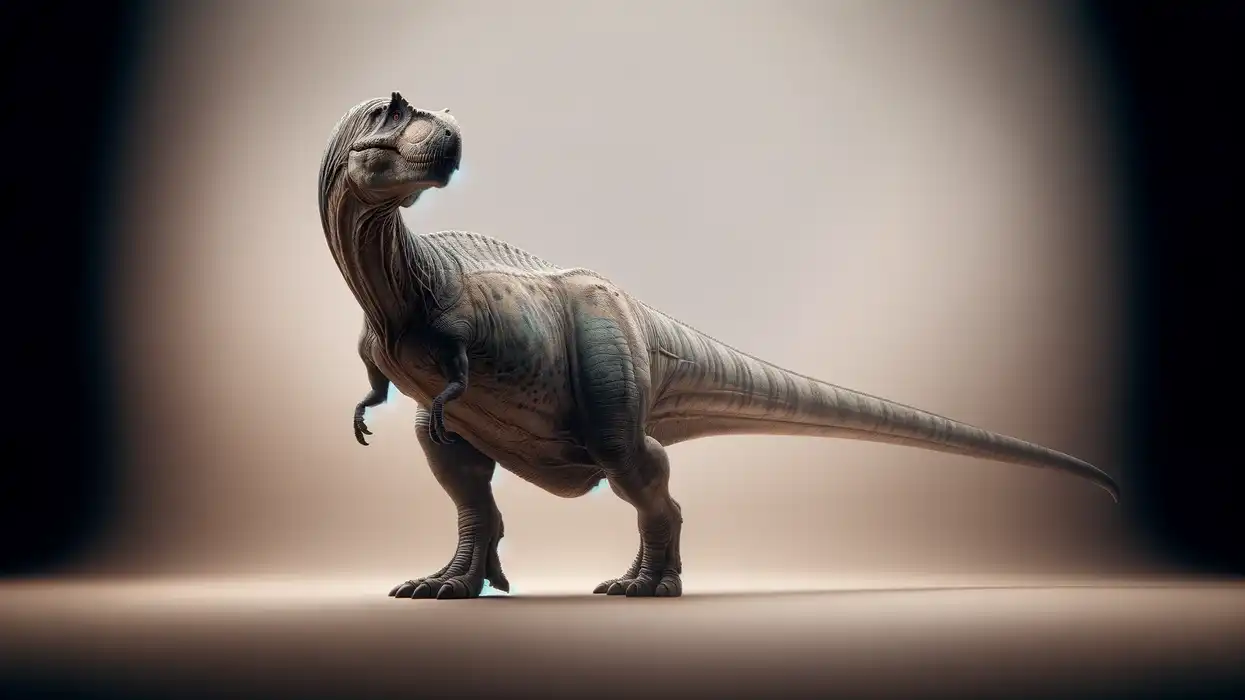Dinosaur remains are found in almost all parts of the world including places like Antarctica where the possibility of dinosaur survival was least expected. The Pradhania is one of the few dinosaurs discovered in India.
It is a new dinosaur species from the upper Triassic, Upper Maleri, and Lower Dharmaram Formation in India and was described by a group of paleontologists, T. S. Kutty, Sankar Chatterjee, Peter M, and Marctic D Ezcurra in 2007. Only one specimen (Type species: Pradhania gracilis) has been found so far.
Pradhania provides two Massospondylidae synapomorphies discovered during their evolutionary analysis.
It is only known from fragmentary remains and hence has been hard to study. Several types of research are conducted to understand the species in a better manner.
To know more about Pradhania, its size, habitat, discovery, and fun facts keep reading and do check out our other free articles on Isisaurus and Abrosaurus.
Pradhania Interesting Facts
How do you pronounce 'Pradhania'?
Pradhania is a member of the Saurischia clade and was discovered in India and named by Kutty, Sankar Chatterjee, Peter M, and Marctic D Ezcurra in the year 2007. It is pronounced as 'pra-dan-ia'.
What type of dinosaur was a Pradhania?
This new dinosaur species belongs to the genus of massospondylid sauropodomorph dinosaur.
In which geological period did the Pradhania roam the Earth?
This is a species from the upper Triassic, Upper Maleri, and lower Dharmaram Formation of India. It roamed the Earth during the Sinemurian age of the Lower or Early Jurassic period.
When did Pradhania become extinct?
Pradhania lived in the Sinemurian age of the lower or early Jurassic period which was 199.3-90.8 million years ago, after which it became extinct. The exact reason for their extinction is not known. It might have been due to natural disasters like volcanic eruptions, tsunamis, or habitat loss.
Where did Pradhania live?
Their fossils have been recovered from places such as Telangana, India.
What was the Pradhania's habitat?
It was a herbivorous animal and is most likely to have occupied forests where food availability was abundant. It might have resided in areas close to water sources where plant life thrived.
Who did Pradhania live with?
From the recovered remains it is not possible to determine whether this species was solitary or lived in packs. Based on the sequences of fossilized footprints called trackways the general findings state that plant-eating dinosaurs mostly stuck together and lived in groups to ward off predators.
It might have shared its habitat with Lamplughsaura, from the Sinemurian age (Early Jurassic) Dharmaram Formation of India.
How long did a Pradhania live?
The exact lifespan of this species is not known. Dinosaurs in general could have lived anywhere between 10-80 years.
How did they reproduce?
A few dinosaur eggs have been discovered which indicates that they were oviparous and reproduced by laying eggs. Research suggests that the reproduction in dinosaurs must have been quite similar to all modern-day reptiles which involved deposition of sperms inside females, fertilization of eggs, incubation, and hatching of eggs.
Some of the dinosaurs did care a great deal for their young while the rest were left to fend for themselves. Due to lack of data, we do not know if Pradhania belonged to the former or latter groups.
Pradhania Fun Facts
What did Pradhania look like?
 We've been unable to source an image of Pradhania and have used an image of Massospondylus instead. If you are able to provide us with a royalty-free image Pradhania, we would be happy to credit you. Please contact us at hello@kidadl.com
We've been unable to source an image of Pradhania and have used an image of Massospondylus instead. If you are able to provide us with a royalty-free image Pradhania, we would be happy to credit you. Please contact us at hello@kidadl.com
Pradhania is only known from fragmentary remains discovered by Dhuiya Pradhan. The presents a moderate size skeleton. All members of the Sauropodomorpha clade had long necks and long tails which possessed one to three extra sacral vertebrae.
They had leaf-shaped teeth which were not very strong. Unlike all other herbivorous dinosaurs that possessed grinding teeth, this species had grinding stones also known as gastroliths, similar to modern-day birds, in place of the grinding teeth.
Since their teeth were suitable to grind plant matter these stones aided in grinding the food. Their nostrils were quite large and one of the distinct features. The long claw present in the thumb was not put to use unless provoked.
How many bones did a Pradhania have?
Humans have discovered dinosaur bones that are several million years old and have been fossilized. As a result, calculating the exact number of bones a dinosaur had is not possible.
Not all of the bones of a dinosaur are found during an excavation. Only parts of the skeleton are discovered, and the rest of the estimations are made based on reconstruction. Research made by scientists suggests that these dinosaurs might have had as many as 200-300 bones.
How did they communicate?
As weird as it seems, Pradhania might have used its long whip-like tail to make loud, explosive noises. It is a general behavior observed in the Sauropodomorph clade.
The tail bones had certain injuries which led the scientists to this conclusion. It was primarily employed as a defensive sound to keep predators at bay. Aside from that, they may have made loud hooting noises to communicate with other members.
How big was Pradhania?
The fossil reconstruction presents a medium-sized skeleton that measured approximately 13 ft (4 m) in length. The height of this dinosaur has not yet been determined. It is two times the length of a Velociraptor.
How fast could a Pradhania move?
Based on the analysis, the estimated speed of a dinosaur is determined using parameters such as limb length and estimated body mass. Members of the Massospondylidae family were bipedal to quadrupedal, however would have relied on the hind legs mostly for locomotion.
They possessed powerful, well-built legs that allowed them to sprint quickly. They were probably not as quick as Struthiomimus. The long tails may have provided them with incredible balance as they twirled and twisted while sprinting.
How much did a Pradhania weigh?
Based on estimations, Pradhania weighed around 551 lb (250 kg).
What were the male and female names of the species?
There were no opportunities to examine or interpret features of the male and female species due to a lack of fossils. Hence they did not have any unique names and were generally referred to as Pradhania.
What would you call a baby Pradhania?
A baby Pradhania can be called a hatchling, nestling, or juvenile.
What did they eat?
Dinosaurs are classified for their dietary preferences based on the teeth structure. In the case of Pradhania, it had teeth that were neither sharp nor long. It meant that they were only capable of crushing plant material. Based on their neck length, it was concluded that they were terrestrial herbivores.
Due to its long neck, it could feed on plants at great heights without breaking a sweat. They would have primarily eaten leaves and twigs and fed on a lot of seeds and other plant components to keep their size up.
How aggressive were they?
They would have been moderately aggressive. Though they weren't super huge, they had extraordinary defense skills. The short arms and strong nails ould have aided greatly in defense. However, they were generally calm unless threatened or provoked.
Did you know...
Pradhania gracilis was a basal sauropodomorph dinosaur. The early dinosaurs belonging to the Sauropodomorpha family were among the least intelligent dinosaurs.
The Pradhania skeleton is one of the 15-20 dinosaur remains found in India.
This species was initially regarded as a primitive Saudomorph. However, the most recent cladistic analysis, done in 2011 by Novas et al., revealed that they were massospondylids.
Despite being discovered earlier by Dhuiya Pradhan, the anatomical analysis and relationships were given at a later period (2011) by T. S. Kutty, Sankar Chatterjee, Peter M, Fernando Novas, and Marctic D Ezcurra.
Why are they called Pradhania?
Pradhania is a genus of massospondylid sauropodomorph dinosaur named by T. S. Kutty, Sankar Chatterjee, Peter M, and Marctic D Ezcurra in the year 2007. It was given this name to honor Dhuiya Pradhan, a fossil collector at the Indian Statistical Institute.
Who discovered Pradhania?
The fossil of Pradhania was discovered in places such as Telangana situated in India by Dhuiya Pradhan, a fossil collector at the Indian Statistical Institute.
Here at Kidadl, we have carefully created lots of interesting family-friendly dinosaur facts for everyone to discover! Learn more about some other creatures from our Puertasaurus facts and Panphagia facts pages.
You can even occupy yourself at home by coloring in one of our free printable Pradhania coloring pages.









